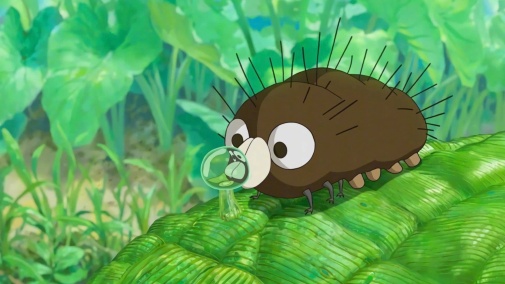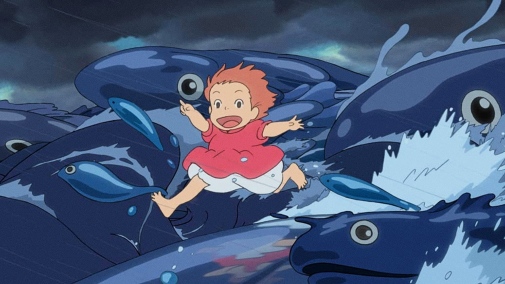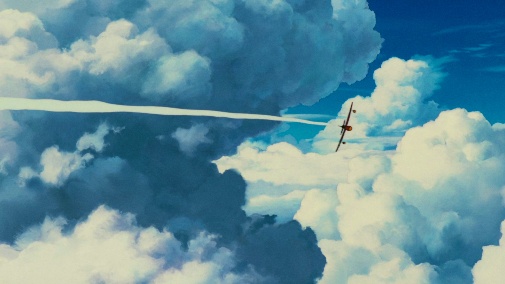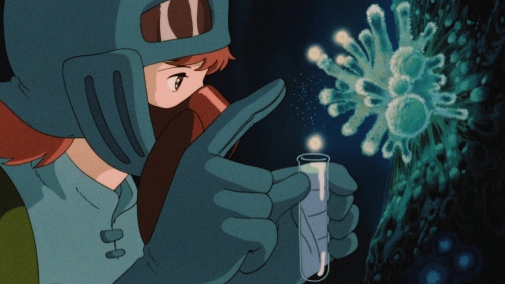My Miyazaki Ranking: Part Two – Princesses & Pigs
 Saturday, March 23, 2024 at 5:00PM
Saturday, March 23, 2024 at 5:00PM 
If you've ever seen the Never-Ending Man documentary, you'll be familiar with Hayao Miyazaki's complex relationship with new technologies, in animation and otherwise. The film's most famous quote relates to AI, which the Ghibli co-founder strongly feels is "an insult to life itself." However, there's more to it since Miyazaki has attempted and succeeded in combining the possibilities of CGI with traditional techniques. You can see this in the same non-fiction work as the director unsteadily creates Boro, the Caterpillar, one of those shorts exclusively screened at the Ghibli Park and Museum. Still, even as the result may dazzle, the process to get there is a barrage of frustrations for the old master.
Today's Miyazaki tryptic goes against hybridized approaches. Instead, it finds an embrace of hand-drawn animation in its purest form, divested of computerized witchcraft and the like…

09. PONYO (2008)
The production of Princess Mononoke was so exhausting it led to Miyazaki's first retirement announcement. Glancing at that picture's epic scale, such reaction is unsurprising, and one can say the same for Spirited Away, its follow-up in the director's filmography. Then came Howl's Moving Castle, which Miyazaki wasn't even meant to direct, and a litany of technological conundrums to do with the integration of 3-D rendering into Ghibli's workflow – the castle itself being the greatest challenge of them all. For a while, it seemed like the Studio would continue to grow in ambition, leaving the erstwhile simplicity of its origins as a faint memory.
And that's precisely why Ponyo came to be, almost like a direct response to the dereliction of hand-drawn humility and a call to arms by Miyazaki. Unlike all those massive endeavors, this would be a simple fairytale about small children, close to a retelling of The Little Mermaid. Moreover, every single frame would be animated in the traditional manner. Computer aids were out and the expressivity of pen on paper was in. Even the backgrounds reveal this ethos with their colored pencil texture, a child's storybook drawing come to life. The water – and there's a lot of it – was nearly all done by Miyazaki, each ripple and wave bubbling with personality.
In some ways, the director was trying to rekindle his love for the art form, going back to basics, so to speak. But of course, that doesn't mean Ponyo is lackluster in any regard. I've already praised the water animation, but every little movement on-screen vibrates with the excitement of a creative hand set free. There's no other explanation for the batshit driving featured in some of Ponyo's most frenzied sequences. If that wasn't enough, Joe Hisaishi is doing some of his best work on the movie's soundtrack, from the motherly song over the opening credits to the peppy tune that bids us farewell.
Trying to find a justification for the picture's low position on the ranking is a tough job. It could be a matter of Miyazaki having so many works that approach masterpiece status. Then again, the insistence on reading the story's central relationship as romantic always alienates me a tad from its conflict – as it did in Howl – and the juxtaposition of toddler antics and apocalyptic consequences doesn't always gel. At its best, Ponyo portrays a child's perspective with commendable sincerity while leaving space for the stresses of parenthood at the narrative's margins, a shade of maturity that makes the fantasy that much sweeter. The supporting characters being more captivating than the leads is something of an issue, but a small one.

08. PORCO ROSSO (1992)
For an adventure flick starring a talking pig as its hero, Porco Rosso can be surprisingly solemn. Consider a scene of remembrance when our protagonist talks about an experience where worlds collide, life glimpsing into the abyss of what comes after. It's the limbo of flyboys, those mavericks of World War I whose glory days were already behind them, even if they didn't know it yet. Above the clouds, looking up, those beautiful flying machines soar like a trail of starlight, and the survivors stay behind, though they are half-dead already. Loss imbues the frame and so does a sense of existential loneliness.
That melancholy is expected of a story set around the Mediterranean Sea circa 1929, as the world created by one war was about to pit itself into another. Most adults in the tale – and this is the rare Miyazaki film where a juvenile POV seldom manifests – know they belong to an era reaching its close. Their way of life is already History, their souls stuck in a past about to become obsolete. Even the stylistic quirks of Porco Rosso point in this direction, embodying cinematic tropes and affectations confined to yesteryear. Indeed, in one rollicking moment, Miyazaki pays homage to the rubber-hose animation of silent movies, a comedic highlight that nevertheless rings with sorrow.
I fear I'm making this action picture sound like a weepy affair. Porco Rosso is nothing of the sort, often operating at a level of broad comedy whenever it's not indulging in some of the most electrifying aerial dogfights imaginable. It's a matter of tonal multidimensionality, every jest hiding some serious reflection behind its back. Consider the story's political angle, ridiculing fascists as little more than a slapstick nuisance to the heroes who battle them. Yet, we know what such people will bring into the world depicted in Porco Rosso, the evil they're capable of once they accrue enough power. By playing up the comedy, Miyazaki is anticipating the inevitable horror. He's making a lark whose mirth is a prelude to tragedy.
And to think Porco Rosso started life as a piece of short in-flight entertainment for Japan Airlines! Initially, the director was meant to adapt one of his manga into a fun little thing, but the shadow of war loomed heavily over the production. Haunted by what was happening in Europe at the time, Miyazaki expanded the idea into a feature suffused with anti-war sentiment. Ultimately, it became an opportunity to combine many passions and concerns. One immediately recognizes his love for military aircrafts – depicted even more romantically than they are in The Wind Rises – but there's also his appreciation of classic cinema and Italian music. If you don't believe me, listen to Joe Hisaishi's score. That man was clearly riffing on the work of composers like Morricone and Rota.

07. NAUSICAÄ OF THE VALLEY OF THE WIND (1984)
Ghibli and many of its fans like to claim Nausicaä of the Valley of the Wind as one of its productions though that film predates the Studio's existence. Fair enough, it's an understandable impulse, considering how masterful and downright influential the picture remains. To this day, you can find its echoes throughout the sci-fi genre as it exists on the silver screen. Think about Rey's introduction in The Force Awakens, how it replicates many of the same beats of Nausicäa's entrance. Then there's the golden imagery borrowed by James Cameron for Avatar and the first act of Snyder's latest, which is as indebted to Miyazaki as to Kurosawa.
Hell, the path to Neon Genesis Evangelion started here, when Miyazaki tasked a young Hideaki Anno with animating the God Warrior's attack and instant decay. The sinewy spin on mecha imagery is an undeniable influence on the Evas' eventual form and concept. At the same time, Nausicaä looks to the past. Many of its ideas are already present in Miyazaki's Future Boy Conan anime, dating back to 1978, and the director himself has cited René Laloux's Fantastic Planet as an essential reference. And, of course, there's Dune. Re-watching Nausicaä while the second part of Villeneuve's Frank Herbert adaptation spices the box office, one's tempted to ruminate on their similarities.
That being said, what separates them might be more thought-provoking. As Hoan-Tran Bui articulated in an article for Inverse, for all that Dune is a landmark of eco-sci-fi, the books are always more interested in the consequences of Humanity's actions unto itself. Though a paragon of Humanistic cinema, Miyazaki's weary vision of tomorrow often foregrounds the effects of human action on nature. The megafauna of both stories is alike in scale and portent, but the Shai-Hulud of Arrakis are forever distant, more object than being within the narrative. On the other hand, the princess of the Valley of the Wind reaches toward the monstrous Ohm and, through her, Miyazaki makes us empathize with the creatures.
Herbert's prophesized fates are a product of nefarious religious artifice, while Miyazaki sees Nausicaä's destiny as a responsibility, hope instead of a nightmare. That might be what makes this film so unique compared to Dune and beyond. Nausicaä of the Valley of the Wind never loses faith or falls into nihilism, it struggles and fights for a better future as its heroine soars over a broken world. Such strengths extend past the text, for Miyazaki has devised a vision where beauty and rot can coexist, painterly backdrops of poisonous fungi and machinery that can destroy as easily as it can protect. It's a stunning achievement that hasn't lost an ounce of power in the forty years since its original release.
All three of these films are currently streaming on Max. You can also rent and purchase them on Apple TV, Amazon, Google Play, YouTube, VUDU, and the Microsoft Store.



